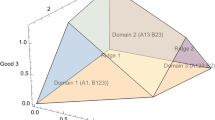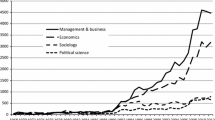Abstract
Dopfer and Potts (2008) have proposed a new analytic foundation to evolutionary economics based on the unified rule approach. While they contend that their approach is ontologically and analytically coherent and useful, scholars sympathetic with it, e.g., Ostrom and Basurto (2011), have called for further methodological and empirical specification. In the same vein, this paper seeks to develop the Dopfer-Potts framework by proposing an analytic methodology to translate their rule-based approach into an operational method for identifying and testing hypotheses that relate to rules. It does so by defining a methodology connecting explanandum (response rule) and explanantia (factor rules) at the same level of rules. The concept of a ‘savings rule’ serves as a roving example that later is extended into a case study. The paper offers a methodological template for applied evolutionary analysis in economics.
Similar content being viewed by others
Notes
For reasons of simplicity, we refer to ‚generic rules’ as ‚rules’ throughout this contribution.
Ostrom and Basurto refer to these systems as ‚configurations’ (2010:318).
For the distinction between the analytical levels of rules and of operations, compare Table 1 in Dopfer K and Potts J (2009) On the Theory of Economic Evolution. Evolutionary and Institutional Economic Review 6(1):23–44.
It is insightful to compare the rule world of Ostrom with that of the RBA. There is a close correspondence with regard to 1st order social and behavioral rules and to 0th order rules. Ostrom’s “boundary rules” and “payoff rules” closely correspond to 0th order constitutional rules, and her “choice rules” and “position rules” fit well the bracket of 1st order rules in the RBA. The 2nd order rules receive little attention in the Ostrom approach, though her first “information rule” may be conceived as a 2nd order rule (a rule pertaining to other rules).
The RBA explicitly includes the possibility of a perfect congruency between the rule level and the operant level as a special case. Yet, as becomes obvious from our example, many empirical phenomena will not come with such congruency.
From our view, the pertinent literature would suggest considering real interest and a precautionary motive implicit in the providence rule, as well as tax law (e.g., Cagetti 2001). However, it might be difficult to identify a hedonist lifestyle (b), as opposed to the intention to bequeath one’s heirs (Hayashi and Ando 1988) exclusively on the basis of a review of extant literature.
For a detailed discussion of the RBA rule taxonomy (orders and classes of rules), refer to Dopfer and Potts (2008:8,9).
References
Aoki M (2001) Towards a Comparative Institutional Analysis. MIT University Press, Cambridge, MA
Axelrod R (1997) The complexity of cooperation: agent-based models of competition and cooperation. Princeton University Press, Princeton
Beinhocker E (2011) Evolution as computation: integrating self-organization with generalized Darwinism. J Inst Econ 7(3):393–423
Blind GD (2012) Investigating entrepreneurial spirit with the rule approach: why self-employment is on the decline in Japan. Evol Inst Econ Rev 9(1):183–198
Brandes W, Weise P (1999) Team Performance as a Constellation of Forces: A General Model. Kyklos 52(4):573–590
Cagetti M (2001) Interest Elasticity in a Life-Cycle Model with Precautionary Savings. Am Econ Rev 91(2):418–421
Cavelaars P (2005) Has the Tradeoff Between Productivity Gains and Job Growth Disappeared? Kyklos 58(1):45–64
Chen K, İmrohoroğlu A, İmrohoroğlu S (2006) The Japanese Saving Rate. Am Econ Rev 96(5):1850–1858
Dawkins R (1976) The Selfish Gene. Oxford University Press, Oxford and New York
De Long JB (1988) Productivity Growth, Convergence, and Welfare: Comment. Am Econ Rev 78(5):1138–1154
Dopfer K (2001) Evolutionary Economics - Framework for Analysis. In: Dopfer K (ed) The Evolutionary Foundations of Economics. Kluwer Academic Publishers, Boston, Dordrecht, London, pp 1–44
Dopfer K (2004) The economic agent as rule maker and rule user: Homo Sapiens Oeconomicus. J Evol Econ 14:177–195
Dopfer K (2005) Evolutionary Economics: A Theoretical Framework. In: Dopfer K (ed) The Evolutionary Foundations of Economics. Cambridge University Press, Cambridge, pp 3–55
Dopfer K (2012) The Origins of Meso Economics - Schumpeter's legacy and beyond. J Evol Econ 22:133–160
Dopfer K, Potts J (2004) Evolutionary realism: a new ontology for economics. J Econ Methodol 11(2):195–212
Dopfer K, Potts J (2008) The General Theory of Economic Evolution. Routledge, London
Dopfer K, Potts J (2010) Why evolutionary realism underpins evolutionary economic analysis and theory: A reply to Runde’s critique. J Inst Econ 6(3):401–413
Fehr E, Gächter S (2002) Altruistic Punishment in Humans. Nature 415:137–140
Grebel T (2012) Network evolution in basic science. J Evol Econ 22:443–457
Hayashi F, Ando A (1988) Life cycle and bequest savings: A study of Japanese and U.S. households based on data from the (1984) NSFIE and the 1983 survey of consumer finances. J Jpn Int Econ 2(4):450–491
Hayek FA (1973) Law, legislation, and liberty: Rules and order. The University of Chicago Press, Chicago
Kaldor N (1975) Economic Growth and the Verdoorn Law - A Comment on Mr Rowthorn's Article. Econ J 85:891–896
Morone P, Taylor R (2004) Knowledge diffusion dynamics and network properties of face-to-face interactions. J Evol Econ 14:327–351
Nelson R, Winter S (1982) An Evolutionary Theory of Economic Change. Harvard University Press, Cambridge MA
North DC (1990) Institutions, Institutional Change and Economic Performance. Cambridge University Press, Cambridge
Ohori K, Takahashi S (2012) Market design for standardization problems with agent-based social simulation. J Evol Econ 22:49–77
Ostrom E, Basurto X (2011) Crafting analytical tools to study institutional change. J Inst Econ 7(3):317–343
Pyka A, Grebel T (2006) Agent-based modelling : a methodology for the analysis of qualitative development processes. In: Billari F, Fent T, Prskanetz A, Scheffran J (eds) Agent-based computational modelling. Physica Verlag, Heidelberg, pp 17–37
Runde J (2009) Ontology and the foundations of evolutionary economic theory: on Dopfer and Potts’ General Theory of Economic Evolution. J Inst Econ 5(3):361–378
Schumpeter JA (1939) Business Cycles: A Theoretical, Historical and Statistical Analysis of the Capitalist Process. McGraw-Hill, New York and London
Strohmaier R (2010) The General Theory of Economic Evolution. Eur J Hist Econ Thought 17(2):352–356
Wäckerle M (2013) On the bottom-up foundations of the Banking-Macro Nexus. Economics: The Open-Access, Open-Assessment E-Journal 7(2013–40):1–45
Acknowledgements
We gratefully acknowledge most helpful comments and suggestions by Jason Potts, Kurt Dopfer, Manuel Wäckerle, Thomas Grebel, Raji Steineck, and two anonymous referees.
Author information
Authors and Affiliations
Corresponding author
Rights and permissions
About this article
Cite this article
Blind, G., Pyka, A. The rule approach in evolutionary economics: A methodological template for empirical research. J Evol Econ 24, 1085–1105 (2014). https://doi.org/10.1007/s00191-014-0382-4
Published:
Issue Date:
DOI: https://doi.org/10.1007/s00191-014-0382-4




